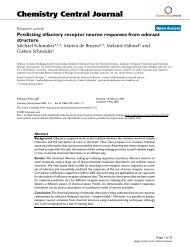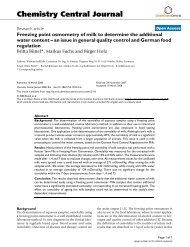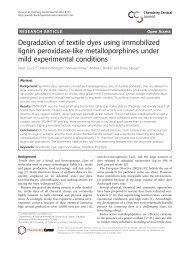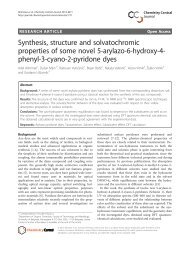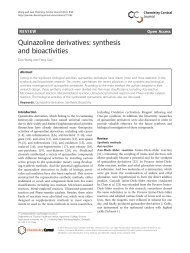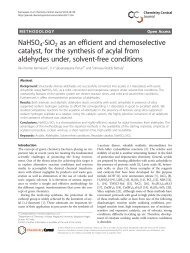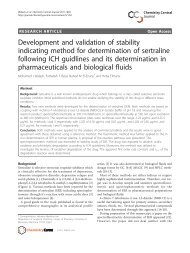Oxidation of benzoin catalyzed by oxovanadium(IV) schiff base ...
Oxidation of benzoin catalyzed by oxovanadium(IV) schiff base ...
Oxidation of benzoin catalyzed by oxovanadium(IV) schiff base ...
You also want an ePaper? Increase the reach of your titles
YUMPU automatically turns print PDFs into web optimized ePapers that Google loves.
Alsalim et al. Chemistry Central Journal 2013, 7:3<br />
http://journal.chemistrycentral.com/content/7/1/3<br />
RESEARCH ARTICLE<br />
Open Access<br />
<strong>Oxidation</strong> <strong>of</strong> <strong>benzoin</strong> <strong>catalyzed</strong> <strong>by</strong> <strong>oxovanadium</strong><br />
(<strong>IV</strong>) <strong>schiff</strong> <strong>base</strong> complexes<br />
Tahseen A Alsalim 1 , Jabbar S Hadi 1 , Omar N Ali 1 , Hanna S Abbo 2 and Salam JJ Titinchi 2*<br />
Abstract<br />
Background: The oxidative transformation <strong>of</strong> <strong>benzoin</strong> to benzil has been accomplished <strong>by</strong> the use <strong>of</strong> a wide<br />
variety <strong>of</strong> reagents or catalysts and different reaction procedures. The conventional oxidizing agents yielded mainly<br />
benzaldehyde or/and benzoic acid and only a trace amount <strong>of</strong> benzil. The limits <strong>of</strong> practical utilization <strong>of</strong> these<br />
reagents involves the use <strong>of</strong> stoichiometric amounts <strong>of</strong> corrosive acids or toxic metallic reagents, which in turn<br />
produce undesirable waste materials and required high reaction temperatures.<br />
In recent years, vanadium complexes have attracted much attention for their potential utility as catalysts for various<br />
types <strong>of</strong> reactions.<br />
Results: Active and selective catalytic systems <strong>of</strong> new unsymmetrical <strong>oxovanadium</strong>(<strong>IV</strong>) Schiff <strong>base</strong> complexes for<br />
the oxidation <strong>of</strong> <strong>benzoin</strong> is reported. The Schiff <strong>base</strong> ligands are derived between 2-aminoethanol and 2-hydroxy-1-<br />
naphthaldehyde (H 2 L 1 ) or 3-ethoxy salicylaldehyde (H 2 L 3 ); and 2-aminophenol and 3-ethoxysalicylaldehyde (H 2 L 2 )or<br />
2-hydroxy-1-naphthaldehyde (H 2 L 4 ). The unsymmetrical Schiff <strong>base</strong>s behave as tridentate dibasic ONO donor<br />
ligands. Reaction <strong>of</strong> these Schiff <strong>base</strong> ligands with oxovanadyl sulphate afforded the mononuclear <strong>oxovanadium</strong>(<strong>IV</strong>)<br />
complexes (V <strong>IV</strong> OL x .H 2 O), which are characterized <strong>by</strong> various physico-chemical techniques.<br />
The catalytic oxidation activities <strong>of</strong> these complexes for <strong>benzoin</strong> were evaluated using H 2 O 2 as an oxidant. The best<br />
reaction conditions are obtained <strong>by</strong> considering the effect <strong>of</strong> solvent, reaction time and temperature. Under the<br />
optimized reaction conditions, VOL 4 catalyst showed high conversion (>99%) with excellent selectivity to benzil<br />
(~100%) in a shorter reaction time compared to the other catalysts considered.<br />
Conclusion: Four tridentate ONO type Schiff <strong>base</strong> ligands were synthesized. Complexation <strong>of</strong> these ligands with<br />
vanadyl(<strong>IV</strong>) sulphate leads to the formation <strong>of</strong> new <strong>oxovanadium</strong>(<strong>IV</strong>) complexes <strong>of</strong> type V <strong>IV</strong> OL.H 2 O.<br />
Elemental analyses and spectral data <strong>of</strong> the free ligands and their <strong>oxovanadium</strong>(<strong>IV</strong>) complexes were found to be in<br />
good agreement with their structures, indicating high purity <strong>of</strong> all the compounds.<br />
Oxovanadium complexes were screened for the oxidation <strong>of</strong> <strong>benzoin</strong> to benzil using H 2 O 2 as oxidant. The effect <strong>of</strong><br />
time, solvent and temperature were optimized to obtain maximum yield. The catalytic activity results demonstrate<br />
that these catalytic systems are both highly active and selective for the oxidation <strong>of</strong> <strong>benzoin</strong> under mild reaction<br />
conditions.<br />
Keywords: Tridentate ONO Schiff <strong>base</strong> ligands, Oxovanadium(<strong>IV</strong>) complexes, Benzoin oxidation, Benzil<br />
Background<br />
Liquid phase catalytic oxidation <strong>of</strong> alcohols is a fascinating<br />
reaction and is one <strong>of</strong> the most important synthetic reactions<br />
in organic chemistry. <strong>Oxidation</strong> <strong>of</strong> <strong>benzoin</strong> to benzil<br />
has been extensively studied for the production <strong>of</strong> fine<br />
chemicals [1-6]. In general α-dicarbonyl compounds are<br />
* Correspondence: stitinchi@uwc.ac.za<br />
2 Department <strong>of</strong> Chemistry, University <strong>of</strong> the Western Cape Bellville, Private<br />
Bag X17, Bellville, Cape Town 7535, South Africa<br />
Full list <strong>of</strong> author information is available at the end <strong>of</strong> the article<br />
important synthetic intermediates in the synthesis <strong>of</strong> many<br />
heterocyclic compounds. α-Dicarbonyl compounds have<br />
diverse applications in organic and pharmaceutical industries<br />
such as photosensitive and synthetic reagents [7,8]<br />
and photo initiators for radical polymerization [9]. Benzil,<br />
in particular, is a standard building block in organic synthesis<br />
and is utilized as an intermediate in the synthesis <strong>of</strong><br />
chiral ligands and biologically active compounds.<br />
The oxidative transformation <strong>of</strong> an α-hydroxy ketone<br />
to the corresponding α-diketone (<strong>benzoin</strong> to benzil) has<br />
© 2013 Alsalim et al.; licensee Chemistry Central Ltd. This is an Open Access article distributed under the terms <strong>of</strong> the Creative<br />
Commons Attribution License (http://creativecommons.org/licenses/<strong>by</strong>/2.0), which permits unrestricted use, distribution, and<br />
reproduction in any medium, provided the original work is properly cited.
Alsalim et al. Chemistry Central Journal 2013, 7:3 Page 2 <strong>of</strong> 8<br />
http://journal.chemistrycentral.com/content/7/1/3<br />
been accomplished <strong>by</strong> the use <strong>of</strong> a wide variety <strong>of</strong><br />
reagents or catalysts and different reaction procedures.<br />
Several reagents have been used for this transformation<br />
such as nitric acid, Th(III) and Y(III) nitrate [10] and<br />
bismuth(III) nitrate-copper(II) acetate [11]. The conventional<br />
oxidizing agents viz., permanganate, dichromate<br />
or chromic acid yielded chiefly benzaldehyde/benzoic<br />
acid and only a trace <strong>of</strong> benzil. The limits <strong>of</strong> practical<br />
utilization <strong>of</strong> these reagents involves the use <strong>of</strong> stoichiometric<br />
amounts <strong>of</strong> corrosive acids or toxic metallic<br />
reagents, which in turn produce undesirable waste materials<br />
and required high reaction temperatures.<br />
In recent years, vanadium complexes have attracted<br />
much attention for their potential utility as catalysts for<br />
various types <strong>of</strong> reactions. Oxovanadium complexes<br />
catalyze various oxidation reactions viz., hydroxylation<br />
<strong>of</strong> phenols [12,13], oxidation <strong>of</strong> sulfides to sulfoxides<br />
[14,15], oxidation <strong>of</strong> alcohols [15], epoxidation <strong>of</strong> olefins<br />
[15-19], hydroxylation <strong>of</strong> benzene to mono- and dihydroxybenzenes<br />
[12,20,21] including reactions such as the<br />
coupling <strong>of</strong> 2-naphthols as well as Mannich-type reactions<br />
[22-25]. Most recently, the application <strong>of</strong> various<br />
<strong>oxovanadium</strong> complexes as catalysts in different oxidation<br />
reactions has been reviewed [26,27].<br />
In this report we describe the synthesis <strong>of</strong> Schiff <strong>base</strong><br />
ligands derived <strong>by</strong> reaction between 2-aminophenol or<br />
2-aminoethanol and 2-hydroxy-1-naphthaldehyde or 3-<br />
ethoxy salicylaldehyde to form tridentate dibasic ligands<br />
<strong>of</strong> the ONO type. Complexation <strong>of</strong> these ligands with<br />
vanadyl sulphate produced <strong>oxovanadium</strong>(<strong>IV</strong>) complexes.<br />
To the best <strong>of</strong> our knowledge, this is the first report<br />
describing the synthesis <strong>of</strong> these <strong>oxovanadium</strong>(<strong>IV</strong>)<br />
complexes.<br />
As part <strong>of</strong> our continuing interest in oxidation reactions<br />
<strong>by</strong> vanadium complexes [13] and considering the demand<br />
<strong>of</strong> more efficient catalytic systems, we undertook an investigation<br />
<strong>of</strong> these <strong>oxovanadium</strong>(<strong>IV</strong>) complexes as catalysts<br />
for benzion oxidation for the first time.<br />
Results and discussion<br />
Synthesis and characterization<br />
Facile condensation <strong>of</strong> 2-aminophenol or 2-aminoethanol<br />
and 2-hydroxy-1-naphthaldehyde or 3-ethoxy salicylaldehyde<br />
in 1:1 molar ratio afforded four Schiff <strong>base</strong> ligands<br />
viz. H 2 L 1 ,H 2 L 2 ,H 2 L 3 and H 2 L 4 , respectively (Scheme 1).<br />
These tridentate ligands reacted readily with vanadyl sulfate<br />
in methanol to form the <strong>oxovanadium</strong> complexes with<br />
the same general structure (Scheme 2).<br />
Spectral data and elemental analysis <strong>of</strong> all the synthesized<br />
ligands and their <strong>oxovanadium</strong>(<strong>IV</strong>) complexes<br />
were in good agreement with their structure, indicating<br />
the high purity <strong>of</strong> all the compounds.<br />
The analytical data <strong>of</strong> the complexes indicates a 1:1<br />
metal: ligand stoichiometry, and hence the Schiff <strong>base</strong>s<br />
act as tridentate dibasic ligands. These ligands can coordinate<br />
through the imino nitrogen and two oxygen<br />
atoms from the deprotonation <strong>of</strong> the phenolic groups as<br />
well as from the aliphatic hydroxyl group. The ligands<br />
react with V(<strong>IV</strong>) to fill three <strong>of</strong> the four equatorial coordination<br />
sites with a water molecule coordinating to<br />
the remaining site.<br />
The IR spectra <strong>of</strong> the ligands and their complexes<br />
were compared to determine any changes during complexation<br />
and to confirm their structures (Additional file<br />
1: Figure S1-S3). The IR spectra <strong>of</strong> the ligands showed a<br />
broad absorption band at 3230–3117 cm -1 attributed to<br />
the stretching vibration <strong>of</strong> intramolecular hydrogen<br />
bonded OH groups [28]. This band disappeared on complexation<br />
indicating the coordination <strong>of</strong> vanadium metal<br />
through OH groups after deprotonation. A new medium<br />
intensity band near 3400–3500 cm -1 is attributed to the<br />
νOH stretching vibration <strong>of</strong> the coordinated water molecule<br />
to the central metal ion [29]. A strong band at<br />
1648–1629 cm -1 <strong>of</strong> the spectra <strong>of</strong> the ligand was<br />
assigned to the azomethine (C=N) stretching vibration.<br />
This band shifted to lower frequency (<strong>by</strong> 10–30 cm -1 )in<br />
the complexes, indicating that the nitrogen atom <strong>of</strong> the<br />
azomethine group is coordinated to the metal centre<br />
[30,31]. The phenolic ν(C–O) band at 1114–1116 cm -1<br />
in the free ligand is shifted towards lower frequency <strong>by</strong><br />
10 ± 15 cm -1 in the complexes, verifying coordination<br />
via the deprotonated phenolic oxygen. The complexes<br />
show a new strong band in the region between 975–987<br />
cm -1 assigned to stretching vibration <strong>of</strong> V=O [32,33]<br />
which indicates its monomeric nature [34]. The absence<br />
<strong>of</strong> significant bands in the frequency range below 900<br />
cm -1 demonstrates no V=O····V bridge vibration [35,36].<br />
A similar monomeric nature <strong>of</strong> related complexes has<br />
also been well established crystallographically [37,38].<br />
The appearance <strong>of</strong> two to three new moderately intense<br />
bands in the low-frequency region <strong>of</strong> 350–500 cm -1 in<br />
the complexes are assigned to stretching frequencies <strong>of</strong><br />
ν(V–N) and ν(V–O) bonds i.e. coordination <strong>of</strong> azomethine<br />
nitrogen as well as phenolic oxygen to the vanadium<br />
metal after deprotonation. The C=C stretching<br />
modes <strong>of</strong> the benzene ring <strong>of</strong> the ligand around 1600<br />
cm -1 does not show any significant shift on complexation.<br />
Thus, the IR data indicates that the Schiff <strong>base</strong>s<br />
behave as dibasic tridentate ligands coordinating<br />
through phenolic and alcoholic oxygens and the azomethine<br />
nitrogen.<br />
The 1 H NMR spectra <strong>of</strong> ligand H 2 L 1 and ligand H 2 L 3<br />
displayed a broad signal corresponding to the OH proton<br />
<strong>of</strong> the ethanol amine moiety at 5.00 and 5.32 ppm,<br />
respectively. The phenolic OH protons appeared as<br />
broad signals at 13.88 and 13.70 ppm, respectively. The<br />
1 H NMR spectra <strong>of</strong> ligands H 2 L 2 and H 2 L 4 displayed the<br />
OH phenolic groups as singlets at 9.77 and 14.2, and
Alsalim et al. Chemistry Central Journal 2013, 7:3 Page 3 <strong>of</strong> 8<br />
http://journal.chemistrycentral.com/content/7/1/3<br />
OH<br />
N<br />
OH<br />
O<br />
N<br />
OH<br />
OH<br />
N OH<br />
OH<br />
O<br />
N<br />
OH<br />
OH<br />
CH 3<br />
L 1 L 2 L 3 L 4<br />
Scheme 1 Structure <strong>of</strong> the ligands.<br />
10.35 and 15.7 ppm, respectively [39]. In all the ligands<br />
the azomethine HC=N proton appeared as a singlets at<br />
8.35−9.43 ppm. All the other aromatic and aliphatic protons<br />
were observed in the expected regions (Additional<br />
file 1: Figure S4-S7).<br />
The elemental analyses <strong>of</strong> the ligands and the complexes<br />
are in agreement with their formulation. The<br />
elemental analysis <strong>of</strong> the complexes confirms a 1:1<br />
(metal: ligand) stiochiometry.<br />
The result <strong>of</strong> mass spectra further indicates that the V<br />
(<strong>IV</strong>) complexes have a monomeric form <strong>of</strong> 1:1 stiochiometry,<br />
where the observed molecular ion peak (m/z)<br />
values are consistent with the calculated value in the<br />
proposed structure (Additional file 1: Figure S8-S11).<br />
The complexes were non-volatile and difficulties were<br />
experienced to record their mass spectra <strong>by</strong> E1 methods.<br />
Scheme 2 General structure <strong>of</strong> <strong>oxovanadium</strong>(<strong>IV</strong>) complexes.<br />
Catalytic activity studies<br />
The catalytic activity <strong>of</strong> <strong>oxovanadium</strong> complexes for the<br />
oxidation <strong>of</strong> <strong>benzoin</strong> to benzil has been studied and the<br />
effect <strong>of</strong> time, solvent and temperature were optimized<br />
to produce maximum yield. <strong>Oxidation</strong> did not proceed<br />
when the reaction was carried out in the presence <strong>of</strong> either<br />
hydrogen peroxide or <strong>oxovanadium</strong> complexes<br />
only.<br />
Progress <strong>of</strong> the reaction (as determined <strong>by</strong> the concentration<br />
<strong>of</strong> benzil) was monitored spectrophotometrically<br />
and identification <strong>of</strong> the product was confirmed <strong>by</strong> GC-<br />
MS analyses which showed that benzil was the only<br />
product detectable. No oxidative cleavage products were<br />
observed.<br />
The electronic spectrum <strong>of</strong> benzil is characterized <strong>by</strong><br />
an absorption at 283 nm, which is readily differentiated<br />
from the other absorption bands <strong>of</strong> benzil at 260 nm<br />
and <strong>benzoin</strong> 247 nm [40]. Accordingly, the band at<br />
283 nm was used to determine the concentration <strong>of</strong> the<br />
produced benzil (Figure 1).<br />
In order to screen the catalytic oxidative potential <strong>of</strong><br />
the prepared complexes, they were tested for oxidation<br />
<strong>of</strong> <strong>benzoin</strong> using H 2 O 2 as an oxidant under different reaction<br />
conditions viz., temperature, reaction time and<br />
type <strong>of</strong> solvent in order to optimise the conditions for<br />
the best performance <strong>of</strong> the catalyst.<br />
Figure 2 shows that the absorbance at 283 nm increases<br />
with reaction time as an indication <strong>of</strong> the increasing concentration<br />
<strong>of</strong> benzil <strong>by</strong> using one <strong>of</strong> the catalysts, namely<br />
VOL 1 . The maximum benzil yield was found to depend<br />
upon the type <strong>of</strong> catalyst used (Figure 3). It is clear from<br />
Figure 3 that VOL 4 and VOL 1 give higher benzil yields<br />
compared to VOL 3 and VOL 2 with the same reaction<br />
time. VOL 4 gave 100% yield after 2 h, while VOL 1 gave
Alsalim et al. Chemistry Central Journal 2013, 7:3 Page 4 <strong>of</strong> 8<br />
http://journal.chemistrycentral.com/content/7/1/3<br />
Figure 1 Absorption spectra <strong>of</strong> <strong>benzoin</strong> and benzil in acetonitrile.<br />
98.9% after a longer reaction time (4 h). The order<br />
<strong>of</strong> catalytic activity was found to be as follows: VOL 4 ><br />
VOL 1 >VOL 3 >VOL 2 .<br />
Effect <strong>of</strong> solvent<br />
The influence <strong>of</strong> three different solvents viz. benzene,<br />
carbon tetrachloride and acetonitrile on the rate <strong>of</strong> <strong>benzoin</strong><br />
oxidation was next studied.<br />
Figures 4, 5, 6, 7 illustrate the effect <strong>of</strong> solvent upon the<br />
rate and yield <strong>of</strong> <strong>benzoin</strong> using catalysts (VOL 1 −VOL 4 ). It<br />
is clear from the figures that the solvent has no significant<br />
effect on the yield and selectivity. However, the reaction<br />
rate during the first four hours increases slightly as the polarity<br />
<strong>of</strong> the solvent decreases. Lower reaction rates were<br />
observed using the polar aprotic solvent, acetonitrile, compared<br />
to the other two solvents. On the other hand, the<br />
protic solvent, methanol, was not tried as it retards the<br />
oxidation <strong>of</strong> <strong>benzoin</strong> due to hydrogen bonding with the<br />
methanol [41].<br />
In general, in these solvents, the order <strong>of</strong> the catalytic<br />
performance <strong>of</strong> these catalysts after 6 h reaction time as<br />
the following VOL 1 ≅ VOL 4 >VOL 3 > VOL 2 .<br />
Effect <strong>of</strong> temperature<br />
The performance <strong>of</strong> the catalysts was investigated at two<br />
different temperatures viz. 30°C and 50°C in benzene<br />
after 5 h reaction time (Figure 8).<br />
Time<br />
Figure 2 Change in the absorption spectra with time using VOL 1 .
Alsalim et al. Chemistry Central Journal 2013, 7:3 Page 5 <strong>of</strong> 8<br />
http://journal.chemistrycentral.com/content/7/1/3<br />
Yield (%)<br />
100<br />
80<br />
60<br />
40<br />
20<br />
VOL1<br />
VOL2<br />
VOL3<br />
VOL4<br />
0<br />
0 1 2 3 4<br />
Time (h)<br />
Figure 3 Catalytic performance <strong>of</strong> the different catalysts with<br />
time for the formation <strong>of</strong> benzil in benzene at 50°C.<br />
In general, the catalytic activity <strong>of</strong> the four catalysts<br />
increased with increasing temperature. Figure 8 shows<br />
that there was a significant increase in benzil yield using<br />
VOL 1 , VOL 2 and VOL 3 when the reaction temperature<br />
was increased from 30°C to 50°C; while VOL 4 gave a high<br />
benzil yield (97%) even at the lower temperature i.e. 30°C<br />
and a minor increase at 50°C. At 30°C, moderate yields <strong>of</strong><br />
benzil were observed in all three solvents. However, the<br />
increase in reaction temperature to 50°C led to almost<br />
complete conversion <strong>of</strong> <strong>benzoin</strong> to benzil. Excellent selectivity<br />
was observed with all the catalysts. Thus from the<br />
results above it is clear that 50°C is the optimum<br />
temperature for this oxidation. All the catalysts possess<br />
excellent selectivity towards benzil formation.<br />
Effect <strong>of</strong> time<br />
The catalytic oxidation <strong>of</strong> <strong>benzoin</strong> using H 2 O 2 as oxidant<br />
in the presence <strong>of</strong> the four catalysts was followed<br />
Yield (%)<br />
100<br />
80<br />
60<br />
40<br />
20<br />
MeCN<br />
CCl4<br />
Benzene<br />
0<br />
0 2 4 6 8 10<br />
Time (h)<br />
Figure 5 Effect <strong>of</strong> solvent on % yield <strong>of</strong> benzil using VOL 2<br />
at 50°C.<br />
as a function <strong>of</strong> time in benzene at 50°C. The reaction<br />
pr<strong>of</strong>iles (Figure 3) showed that the yield <strong>of</strong> benzil<br />
increased with increasing reaction time until a steady<br />
state was reached after 2-4 h. However, maximum yield<br />
<strong>of</strong> benzil (>99.9%) was obtained using VOL 1 and VOL 4 ,<br />
and ca. 90% using VOL 2 and VOL 3 . VOL 4 achieved the<br />
maximum conversion within a shorter reaction time<br />
than the other catalysts. The selectivity <strong>of</strong> all the catalysts<br />
was found to be unaffected with increasing reaction<br />
time i.e. >99.9% benzil.<br />
Experimental section<br />
Materials<br />
Oxavanadium sulfate trihydrate, 2-aminophenol and 2-<br />
hydroxy-1-naphthaldehyde were obtained from Fluka, 2-<br />
aminoethanol, 3-ethoxysalicylaldehyde and <strong>benzoin</strong> were<br />
obtained from Merck 30% H 2 O 2 . All other chemical<br />
reagents were used as such. Solvents were used after<br />
being purified according to the standard methods.<br />
100<br />
80<br />
100<br />
80<br />
Yeild (%)<br />
60<br />
40<br />
20<br />
MeCN<br />
CCl4<br />
Benzene<br />
Yield (%)<br />
60<br />
40<br />
20<br />
MeCN<br />
CCl4<br />
Benzene<br />
0<br />
0 2 4 6 8 10<br />
Time (h)<br />
Figure 4 Effect <strong>of</strong> solvent on % yield <strong>of</strong> benzil using VOL 1<br />
at 50°C.<br />
0<br />
0 2 4 6 8 10<br />
Time (h)<br />
Figure 6 Effect <strong>of</strong> solvent on % yield <strong>of</strong> benzil using VOL 3<br />
at 50°C.
Alsalim et al. Chemistry Central Journal 2013, 7:3 Page 6 <strong>of</strong> 8<br />
http://journal.chemistrycentral.com/content/7/1/3<br />
Yield (%)<br />
100<br />
80<br />
60<br />
40<br />
20<br />
MeCN<br />
CCl4<br />
Benzene<br />
0<br />
0 2 4 6 8 10<br />
Time (h)<br />
Figure 7 Effect <strong>of</strong> solvent on % yield <strong>of</strong> benzil using VOL 4<br />
at 50°C.<br />
Physical methods and analysis<br />
Infrared spectra were recorded as KBr pellets on a BUCK-<br />
500 FT-IR spectrometer. 1 H NMR spectra were recorded<br />
on a Bruker 500 (500 MHz) spectrometer using DMSO-d 6<br />
as a solvent and TMS as internal standard. GC-MS were<br />
recorded on a Hewlett Packard E1 mass spectrometer at<br />
70 eV. Elemental analysis was performed on Euro Vectro<br />
EA 3000A analyzer. All <strong>catalyzed</strong> reaction products were<br />
analyzed using UV–vis PG Instrument T-80 + .<br />
Preparation methods<br />
General method for preparation <strong>of</strong> Schiff <strong>base</strong> ligands<br />
Methanolic solutions <strong>of</strong> the aldehyde and amine were<br />
mixed at room temperature in a 1: 1 molar ratio using<br />
glacial acetic acid as a catalytic agent. The resulting mixture<br />
was refluxed for 2 h. The crystalline product was<br />
obtained from the deep-yellow coloured solution after<br />
standing for a few hours at 25°C. The precipitate was filtered<br />
<strong>of</strong>f and washed with ice-cold methanol. The pure<br />
compound was obtained <strong>by</strong> recrystallization from a suitable<br />
solvent.<br />
H 2 L 1 1-{[(2-hydroxyethyl)imino]methyl}-2-naphthol<br />
2-Hydroxy-1-naphthaldehyde (1.72 g), 2-aminoethanol<br />
(0.61 g), (69% yield) as orange needles (from ethanol);<br />
Yield (%)<br />
100<br />
80<br />
60<br />
40<br />
20<br />
0<br />
54.8<br />
98.9<br />
61.1<br />
89.3 91.1<br />
38.6<br />
97.2 100<br />
VOL1 VOL2 VOL3 VOL4<br />
30°C<br />
50°C<br />
Figure 8 Catalytic performance <strong>of</strong> the catalysts for the<br />
oxidation <strong>of</strong> <strong>benzoin</strong> at two reaction temperatures in benzene<br />
after 5 h reaction time.<br />
mp 148–150°C. Anal. Found: C, 71.69; H, 5.73; N, 6.09.<br />
C 13 H 13 NO 2 requires C, 72.54; H, 6.09; N, 6.51%. IR<br />
(KBr, cm -1 ), 3167br (νOH), 3056 (νC-H Ar), 2917 (νC-H<br />
aliph.), 1641 (νC=N); 1 H NMR (DMSO-d 6 , δ/ppm): 3.65<br />
(m, 4 H, 2CH 2 ), 5.00 (br, 1H, OH), 6.64-8.00 (m, 6H,<br />
Ar-H), 9.02(s, 1H, HC=N), 13.88 (br, 1H, phenolic OH);<br />
m/z M .+ = 215 (85%), 214 (66%), 184 (<strong>base</strong> peak), 170<br />
(42%). Found 215.00, C 13 H 13 NO 2 requires 215.25.<br />
H 2 L 2 2-ethoxy-6-{[(2-hydroxyphenyl)imino]methyl}phenol<br />
3-Ethoxysalicylaldehyde (1.66 g), 2-aminophenol (1.09 g),<br />
(87% yield) as reddish orange needles (from ethanol); mp<br />
172-174°C. Anal. Found: C, 69.17; H, 5.41; N, 5.13.<br />
C 15 H 15 NO 3 requires C, 70.02; H, 5.88; N, 5.44%. IR (KBr,<br />
cm -1 ), 32100 (νOH), 3060 (νC-H Ar), 2986 (νC-H aliph.),<br />
1629 s(νC=N).<br />
1 H NMR (DMSO-d 6 , δ/ppm): 1.3 (t, 3H,<br />
CH 3 ), 4.06 (q, 2H, 2CH 2 ), 6.78-7.38 (m, 7H, Ar-H), 8.94 (s,<br />
1H,HC=N),9.77(s,1H,OH;aminophenolmoiety),14.20<br />
(s, 1H, OH; 3-ethoxysalicylaldehyde moiety). m/z M .+ =<br />
257 (86%), 242 (41%) [M-CH 3 ] .+ , 212 (24%) [M-<br />
OCH 2 CH 3 ] .+ , 120 (55%), 69 (<strong>base</strong> peak). Found 257.00,<br />
C 15 H 15 NO 3 requires 257.29.<br />
H 2 L 3 2-ethoxy-6-{[(2-hydroxyethyl)imino]methyl}phenol<br />
3-Ethoxysalicylaldehyde (1.66 g), 2-aminoethanol<br />
(0.61 g), (81% yield) as yellow crystals (from ethanol);<br />
mp 88-90°C. Anal. Found: C, 62.25; H, 6.91; N, 6.41.<br />
C 11 H 15 NO 3 requires C, 63.14; H, 7.23; N, 6.69%. IR<br />
(KBr, cm -1 ), 3230 (νOH), 3050 (νC-H Ar), 2953–2866<br />
(νC-H aliph.), 1652 (νC=N).<br />
1 H NMR (DMSO-d 6 , δ/<br />
ppm): 1.6 (t, 3H, CH 3 ), 3.70 (t, 2H, CH 2 <strong>of</strong> CH 2 N=CH),<br />
3.90 (t, 2H, CH 2 <strong>of</strong> CH 2 OH), 5.32 (s, 1H, OH), 6.70-7.91<br />
(m, 3H, Ar-H), 8.35(s, 1H, HC=N), 13.70 (br, 1H, OH<br />
phenolic OH); m/z M .+ = 209 (13%) C 11 H 15 NO 3 , 194<br />
(20%) [M-CH 3 ] .+ , 164 (25%) [M-OCH 2 CH 3 ] .+ , 69 (<strong>base</strong><br />
peak) (C 2 H 5 NO + ). Found 209.00, C 11 H 15 NO 3 requires<br />
209.23.<br />
H 2 L 4 1-{[(2-hydroxyphenyl)imino]methyl}-2-naphthol<br />
2-Hydroxy-1-naphthaldehyde (1.72 g), 2-aminophenol<br />
(1.09 g), (63% yield) as orange needles (from ethanol);<br />
mp 247-249°C. Anal. Found: C, 76.64; H, 4.34; N, 4.96.<br />
C 17 H 13 NO 2 requires C, 77.55; H, 4.98; N, 5.32%. IR<br />
(KBr, cm -1 ), 3117 (νOH), 3053 (νC-H Ar), 2960 (νC-H<br />
aliph.), 1622 (νC=N).<br />
1 H NMR (DMSO-d 6 , δ/ppm):<br />
6.74-8.35 (m, 10H, Ar-H), 9.43 (s, 1H, HC=N), 10.35<br />
(s, 1H, OH phenolic), 15.70 (s, 1H, OH naphthoyl); m/z<br />
M .+ = 263 (75%), 262 (<strong>base</strong> peak) [M-H] .+ . Found<br />
263.00. C 17 H 13 NO 2 requires 263.30.<br />
Preparation <strong>of</strong> the oxavanadium (<strong>IV</strong>) complexes<br />
All complexes were prepared according to the following<br />
procedure: a hot methanolic solution <strong>of</strong> VOSO 4 .3H 2 O<br />
(0.217 g, 1 mmol), was added drop wise to a hot methanolic<br />
solution <strong>of</strong> the ligand (1.5 mmol). The resulting<br />
mixture was stirred for 3 h and the products obtained
Alsalim et al. Chemistry Central Journal 2013, 7:3 Page 7 <strong>of</strong> 8<br />
http://journal.chemistrycentral.com/content/7/1/3<br />
were filtered, washed with hot water then methanol and<br />
dried in air at 90°C.<br />
VOL 1 Dark green ppt., mp>300°C, IR (KBr, cm -1 );<br />
3050 (νC-H arom.), 2936 (νC-H aliph.) 1614 (νC=N),<br />
1512 (νC=C), 1322 (νC-N), 1198 (ν-O), 975 (νV=O).<br />
Anal. Calcd. for C 13 H 13 NO 4 V: C, 52.35; H, 4.36; N, 4.69.<br />
Found: C, 52.51; H, 4.23; N, 4.51. m/z M .+ = 298.<br />
VOL 2 Brown ppt., mp>300°C, IR (KBr, cm -1 ); 3053<br />
(νC-H arom.), 2969–2890 (νC-H aliph.), 1601 (νC=N),<br />
1582 (νC=C), 1294 (νC-N), 1248 (νC-O), 987 (νV=O).<br />
Anal. calcd. for C 15 H 15 NO 5 V: C, 52.95; H, 4.41; N, 4.11.<br />
Found: C, 52.51; H, 4.23; N, 4.39. m/z M .+ = 340.<br />
VOL 3 Green ppt., mp>300°C, IR (KBr,cm -1 ); 3080 (υC-<br />
H arom.), 2951 (υC-H aliph.), 1608 (νC=N), 1505<br />
(νC=C), 1334 (νC-N), 1212 (νC-O), 981 (νV=O). Anal.<br />
calcd. for C 11 H 15 NO 5 V: C, 45.21; H, 5.31; N, 4.79.<br />
Found: C, 45.54; H, 5.23; N, 4.57. m/z M .+ = 292.<br />
VOL 4 Dark green ppt., mp>300°C, IR (KBr,cm -1 ); 3067<br />
(νC-H arom.), 2961 (νC-H aliph.), 1592 (νC=N), 1575<br />
(νC=C), 1338 (νC-N), 1177 (νC-O), 978 (νV=O). Anal.<br />
calcd . for C 17 H 13 NO 4 V: C, 58.96; H, 3.75; N, 4.04.<br />
Found: C, 58.51; H, 3.49; N, 4.19. m/z M .+ = 346.<br />
Catalytic activity study<br />
The catalytic oxidation <strong>of</strong> <strong>benzoin</strong> to benzil was carried<br />
out in a 25 ml flask. In a typical reaction, an aqueous solution<br />
<strong>of</strong> 30% H 2 O 2 (0.015 mmol) (0.5 mL <strong>of</strong> H 2 O 2 stock<br />
solution; 0.017 g in 5 mL CH 3 CN) and <strong>benzoin</strong> (0.01 g,<br />
0.047 mmol) were mixed in 3 mL <strong>of</strong> the solvent used<br />
and the reaction mixture was magnetically stirred and<br />
heated at 30°C or 50°C in an oil bath. An appropriate<br />
amount <strong>of</strong> catalyst (0.003 g) was added to the reaction<br />
mixture and with this, the reaction was considered to<br />
begin. Each run was repeated twice. During the reaction,<br />
the products were analysed after specific time intervals<br />
using UV–vis spectroscopy and later confirmed <strong>by</strong> GC<br />
after considering the response factors <strong>of</strong> the authentic<br />
samples. Samples <strong>of</strong> the reaction mixture (0.1 ml) were<br />
diluted with 10 ml mixture <strong>of</strong> H 2 O:CH 3 CN (1:1) and the<br />
absorbance <strong>of</strong> the solution was measured spectrophotometrically<br />
The effects <strong>of</strong> various parameters, such as<br />
time <strong>of</strong> reaction and type <strong>of</strong> solvent as well as the<br />
temperature <strong>of</strong> the reaction were studied in order to<br />
examine their effect on the reaction product pattern.<br />
Conclusion<br />
Four tridentate ONO type Schiff <strong>base</strong> ligands were synthesized<br />
<strong>by</strong> condensation <strong>of</strong> 2-aminophenol or 2-aminoethanol<br />
with 3-ethoxy salicylaldehyde and 2-hydroxy-1-naphthaldehyde.<br />
Complexation <strong>of</strong> these ligands with vanadyl(<strong>IV</strong>)<br />
sulphate leads to the formation <strong>of</strong> new <strong>oxovanadium</strong>(<strong>IV</strong>)<br />
complexes <strong>of</strong> type V <strong>IV</strong> OL.H 2 O.<br />
Elemental analyses and spectral data <strong>of</strong> the free ligands<br />
and their <strong>oxovanadium</strong>(<strong>IV</strong>) complexes were found to be<br />
in good agreement with their structures, indicating high<br />
purity <strong>of</strong> all the compounds.<br />
Oxovanadium complexes were screened for the oxidation<br />
<strong>of</strong> <strong>benzoin</strong> to benzil using H 2 O 2 as oxidant. The effect<br />
<strong>of</strong> time, solvent and temperature were optimized to<br />
obtain maximum yield. The catalytic activity results<br />
demonstrate that these catalytic systems are both highly<br />
active and selective for the oxidation <strong>of</strong> <strong>benzoin</strong> under<br />
mild reaction conditions.<br />
Additional file<br />
Additional file 1: Figure S1. Ft-IR spectrum <strong>of</strong> H 2 L 1 . Figure S2: FT-IR<br />
spectrum H 2 L 2 .Figure S3: FT-IR spectrum VOL 2 . Figure S4: H-NMR<br />
spectrum H 2 L 1 . Figure S5: H-NMR spectrum H 2 L 2 . Figure S6: H-NMR<br />
spectrum H 2 L 3 . Figure S7: H-NMR spectrum H 2 L 4 . Figure S8: Mass<br />
spectra H 2 L 1 . Figure S9: Mass spectra H 2 L 2 . Figure S10: Mass spectra<br />
H 2 L 3 . Figure S11: Mass spectra H 2 L 4 .<br />
Competing interests<br />
The authors declare that they have no competing interests.<br />
Authors’ contributions<br />
OA carried out the experimental work. TA helped in experimental and<br />
discussion part. JH helped in experimental and discussion part. HA helped in<br />
the discussion, characterization and draft the manuscript. ST helped in the<br />
discussion, characterization and draft the manuscript. All authors read and<br />
approved the final manuscript.<br />
Author details<br />
1 Department chemistry, College <strong>of</strong> Education, University <strong>of</strong> Basrah, Basrah,<br />
Iraq. 2 Department <strong>of</strong> Chemistry, University <strong>of</strong> the Western Cape Bellville,<br />
Private Bag X17, Bellville, Cape Town 7535, South Africa.<br />
Received: 13 November 2012 Accepted: 2 January 2013<br />
Published: 7 January 2013<br />
References<br />
1. Mallat T, Biker A: <strong>Oxidation</strong> <strong>of</strong> alcohols with molecular oxygen on solid<br />
catalysts. Chem Rev 2004, 104:3037–3058.<br />
2. Ebitani K, Ji H-B, Mizugaki T, Kaneda K: Highly active trimetallic Ru/CeO2/<br />
CoO(OH) catalyst for oxidation <strong>of</strong> alcohols in the presence <strong>of</strong> molecular<br />
oxygen. J Mol Catal A: Chem 2004, 212:161–170.<br />
3. Makwana VD, Son Y-C, Howell AR, Suib SL: The role <strong>of</strong> lattice oxygen in<br />
selective benzyl alcohol oxidation using OMS-2 catalyst: A kinetic and<br />
isotope-labeling study. J Catal 2002, 210:46–52.<br />
4. Kobayashi S, Miyamura H, Akiyama R, Ishid T: Highly active, immobilized<br />
ruthenium catalysts for oxidation <strong>of</strong> alcohols to aldehydes and ketones.<br />
Preparation and use in both batch and flow systems. J Am Chem Soc<br />
2005, 127:9251–9254.<br />
5. Ferri D, Mondelli C, Krumeich F, Baiker A: Discrimination <strong>of</strong> active<br />
palladium sites in catalytic liquid-phase oxidation <strong>of</strong> benzyl alcohol. J<br />
Phys Chem B 2006, 110:22982–22986.<br />
6. Jensen DR, Sigman MS: Palladium catalysts for aerobic oxidative kinetic<br />
resolution <strong>of</strong> secondary alcohols <strong>base</strong>d on mechanistic insight. Org Lett<br />
2003, 5:63–65.<br />
7. Vollhardt KPC, Schore NE: Organic Chemistry. New York: 2nd ed, Freeman;<br />
1994:924–929.<br />
8. Kirihara M, Ochiai Y, Takizawa S, Takahata H, Nemoto H: Aerobic oxidation<br />
<strong>of</strong> α-hydroxycarbonyls catalysed <strong>by</strong> trichlorooxyvanadium: Efficient<br />
synthesis <strong>of</strong> α-dicarbonyl compounds. Chem Commun 1999, :1387–1388.<br />
9. Siegel H, Eggersdorfer M: Ketones in Ullmann's Encyclopaedia <strong>of</strong> Industrial<br />
Chemistry. Wienheim: Wiley-VCH; 2002.<br />
10. McKillop A, Swann B, Ford ME, Taylor EC: Thallium in organic synthesis.<br />
XXXVIII. <strong>Oxidation</strong> <strong>of</strong> chalcones, deoxy<strong>benzoin</strong>s, and <strong>benzoin</strong>s with<br />
thallium(III) nitrate (TTN). J Am Chem Soc 1973, 95:3641–3645.
Alsalim et al. Chemistry Central Journal 2013, 7:3 Page 8 <strong>of</strong> 8<br />
http://journal.chemistrycentral.com/content/7/1/3<br />
11. Tymonko SA, Nattier BA, Mohan RS: <strong>Oxidation</strong> <strong>of</strong> <strong>benzoin</strong>s to benzils using<br />
bismuth(III) nitrate-copper(II) acetate.). Tetrahedron Lett 1999, 40:7657–7659.<br />
12. Maurya MR, Kumar M, Titinchi SJJ, Abbo HS, Chand S: Oxovanadium(<strong>IV</strong>)<br />
Schiff <strong>base</strong> complexes encapsulated in zeolite-Y as catalysts for the<br />
liquid-phase hydroxylation <strong>of</strong> phenol. Catal Lett 2003, 86:97–105.<br />
13. Alsalim TA, Hadi JS, Al-Nasir EA, Abbo HS, Titinchi SJJ: Hydroxylation <strong>of</strong><br />
phenol <strong>catalyzed</strong> <strong>by</strong> <strong>oxovanadium</strong>(<strong>IV</strong>) <strong>of</strong> salen-type <strong>schiff</strong> <strong>base</strong><br />
complexes with hydrogen peroxide.). Catal Lett 2010, 136:228–233.<br />
14. de Azevedo Marques AP, Dockal ER, Skrobot FC, Viana Rosa IL: Synthesis,<br />
characterization and catalytic study <strong>of</strong> [N, N0-bis(3-ethoxysalicylidene)-mxylylenediamine]<strong>oxovanadium</strong>(<strong>IV</strong>)<br />
complex. Inorg Chem Commun 2007,<br />
10:255–261.<br />
15. Bunce S, Cross RJ, Farrugia LJ, Kunchandy S, Meason LL, Muir KW, O’Donnell<br />
M, Peacock RD, Stirling D, Teat SJ: Chiral Schiff <strong>base</strong> complexes <strong>of</strong> copper<br />
(II), vanadium (<strong>IV</strong>) and nickel (II) as oxidation catalysts. X-ray crystal<br />
structures <strong>of</strong> [cu (R-salpn) (OH 2)] and [cu (±−busalcx)]. Polyhedron 1998,<br />
17:4179–4187.<br />
16. Maurya MR, Bisht M, Avecilla F: Synthesis, characterization and catalytic<br />
activities <strong>of</strong> vanadium complexes containing ONN donor ligand derived<br />
from 2-aminoethylpyridine. J Mol Catal A: Chem 2011, 344:18–27.<br />
17. Walmsley RS, Tshentu ZR: Imidazole-<strong>base</strong>d vanadium complexes as<br />
haloperoxidase models for oxidation reactions. S Afr J Chem 2010,<br />
63:95–104.<br />
18. Mohebbi S, Nikpour F, Raiati S: Homogeneous green catalyst for<br />
epoxidation <strong>of</strong> cyclooctene <strong>by</strong> mono <strong>oxovanadium</strong>(<strong>IV</strong>) complexes <strong>of</strong><br />
N2O2 donate ligand system. J Mol Catal A: Chem 2006, 256:265–268.<br />
19. Boghaei DM, Mohebi S: Synthesis, characterization and study <strong>of</strong> vanadyl<br />
tetradentate Schiff <strong>base</strong> complexes as catalyst in aerobic selective<br />
oxidation <strong>of</strong> olefins. J Mol Catal A: Chem 2002, 179:41–45.<br />
20. Maurya MR, Agarwal S, Bader C, Ebel M, Rehder D: Synthesis,<br />
characterisation and catalytic potential <strong>of</strong> hydrazonatovanadium(v)<br />
model complexes with [VO]3+ and [VO 2]+ cores. Dalton Trans 2005,<br />
:537–544.<br />
21. Reis PM, Silva JAL, Silva JJRFD, Pombeiro AJL: Peroxidative oxidation <strong>of</strong><br />
benzene and mesitylene <strong>by</strong> vanadium catalysts. J Mol Catal A:Chem 2004,<br />
224:189–195.<br />
22. Reddy P, Chu C-Y, Hwang D-R, Wang S-K, Uang B-J: Recent advances in<br />
the <strong>oxovanadium</strong> mediated biaryl coupling and modified Mannich-type<br />
reaction. Coord Chem Rev 2003, 237:257–269.<br />
23. Hon S-W, Li C-H, Kuo J-H, Barhate NB, Liu Y-H, Wang Y, Chen C-T: Catalytic<br />
asymmetric coupling <strong>of</strong> 2-naphthols <strong>by</strong> chiral tridentate <strong>oxovanadium</strong><br />
(<strong>IV</strong>) complexes. Org Lett 2001, 3:869–872.<br />
24. Guo Q-X, Wu Z-J, Luo Z-B, Liu Q-Z, Ye J-L, Luo S-W, Cun L-F, Gong L-Z:<br />
Highly enantioselective oxidative couplings <strong>of</strong> 2-naphthols <strong>catalyzed</strong> <strong>by</strong><br />
chiral bimetallic <strong>oxovanadium</strong> complexes with either oxygen or air as<br />
oxidant. J Am Chem Soc 2007, 129:13927–13638.<br />
25. Luo Z, Liu Q, Gong L, Cui X, Mi A, Jiang Y: Novel achiral biphenol-derived<br />
diastereomeric <strong>oxovanadium</strong>(<strong>IV</strong>) complexes for highly enantioselective<br />
oxidative coupling <strong>of</strong> 2-naphthols. Angew Chem Int Ed 2002, 41:45324535.<br />
26. Licini G, Conte V, Coletti A, Mba M, Zonta C: Recent advances in vanadium<br />
<strong>catalyzed</strong> oxygen transfer reactions. Coord Chem Rev 2011, 255:2345–2357.<br />
27. da Silva JAL, da Silva JJR F, Pombeiro AJL: Oxovanadium complexes in<br />
catalytic oxidations. Coord Chem Rev 2011, 255:2232–2248.<br />
28. Petek H, Albayrak C, Odabasoglu M, Senel I, Buyukgungor O:<br />
Crystallographic and conformational analysis <strong>of</strong> [(Z)-2-ethoxy-6-[(2-<br />
hydroxyphenylamino)methylene] cyclohexa-2,4-dienone]. J Chem<br />
Crystallogr 2008, 38:901–905.<br />
29. Nakamoto K: Infrared and Raman Spectra <strong>of</strong> Inorganic Coordination<br />
Compounds. New York, Wiley and sons:; 1978:229.<br />
30. Syamal A, Kale KS: Magnetic and spectral properties <strong>of</strong> <strong>oxovanadium</strong>(<strong>IV</strong>)<br />
complexes <strong>of</strong> ONO donor tridentate, dibasic Schiff <strong>base</strong>s derived from<br />
salicylaldehyde or substituted salicylaldehyde and o-<br />
hydroxybenzylamine. Inorg Chem 1979, 18:992–995.<br />
31. Goodgame M, Hayward PJ: Infrared spectra (1650–400 cm.-1) <strong>of</strong> γ-<br />
picoline metal co-ordination complexes. J Chem Soc A 1966, :632–634.<br />
32. Selbin J: The chemistry <strong>of</strong> <strong>oxovanadium</strong>(iv). Chem Rev 1965, 65:153–175.<br />
33. Selbin J: Oxovanadium(<strong>IV</strong>) complexes. Coord Chem Rev 1966, 1:293–314.<br />
34. Dinda R, Sengupta P, Ghosh S, Mak TCW: Valence delocalization in a<br />
mixed-oxidation divanadium (<strong>IV</strong>, V) complex electrogenerated from its<br />
structurally characterized divanadium (V) analogue with a tridentate<br />
(ONO) ligand. Inorg Chem 2002, 41:1684–1688.<br />
35. Mathew M, Carty AJ, Palenik GJ: An unusual complex containing bridging<br />
vanadyl groups. The crystal structure <strong>of</strong> N,N0-propylenebis(salicylaldiminato)-<br />
<strong>oxovanadium</strong>(<strong>IV</strong>) [12]. JAmChemSoc1970, 92:3197–3198.<br />
36. Boas LV, Pessoa JC: Vanadium. In Comprehensive Coordination Chemistry<br />
Volume 5. Pergamon Press: Oxford: Edited <strong>by</strong> Willkinson G, Gillard, RD,<br />
McCleverty JA; 1987.<br />
37. Kaitner B, Pavlovic G: Hydrogen Bonded Dimer N-(2-hydroxyethyl)-2-oxy-<br />
1-naphthaldimine and Its Oxo-vanadium(V) Complex. Croat Chem Acta<br />
1999, 72:607–620.<br />
38. Vergopoulos V, Priebsch W, Fritzsche M, Rehder D: Binding <strong>of</strong> L-histidine to<br />
vanadium. Structure <strong>of</strong> exo-[VO2{N-(2-oxidonaphthal)-His}]. Inorg Chem<br />
1993, 32:1844–1849.<br />
39. Venkatachalam TK, Pierens GK, Campitelli MR, Reutens DC: Structural<br />
investigation on phenyl- and pyridin-2-ylamino(methylene) naphthalen-<br />
2(3H)-one. Substituent effects on the NMR chemical shifts. Magn Reson<br />
Chem 2010, 48:585–592.<br />
40. Maurya MR, Sikarwar S, Manikandan P: Oxovanadium(<strong>IV</strong>) complex <strong>of</strong> 2-(αhydroxyethyl)benzimidazole<br />
covalently bonded to chloromethylated<br />
polystyrene for oxidation <strong>of</strong> <strong>benzoin</strong>. Appl Catal A: Gen 2006, 315:74–82.<br />
41. Skobridis K, Theodorou V, Weber E: A very simple and chemoselective air<br />
oxidation <strong>of</strong> <strong>benzoin</strong>s to benzils using alumina. Arkivoc 2006, 10:102–106.<br />
doi:10.1186/1752-153X-7-3<br />
Cite this article as: Alsalim et al.: <strong>Oxidation</strong> <strong>of</strong> <strong>benzoin</strong> <strong>catalyzed</strong> <strong>by</strong><br />
<strong>oxovanadium</strong>(<strong>IV</strong>) <strong>schiff</strong> <strong>base</strong> complexes. Chemistry Central Journal 2013<br />
7:3.<br />
Publish with ChemistryCentral and every<br />
scientist can read your work free <strong>of</strong> charge<br />
Open access provides opportunities to our<br />
colleagues in other parts <strong>of</strong> the globe, <strong>by</strong> allowing<br />
anyone to view the content free <strong>of</strong> charge.<br />
W. Jeffery Hurst, The Hershey Company.<br />
available free <strong>of</strong> charge to the entire scientific community<br />
peer reviewed and published immediately upon acceptance<br />
cited in PubMed and archived on PubMed Central<br />
yours you keep the copyright<br />
Submit your manuscript here:<br />
http://www.chemistrycentral.com/manuscript/





